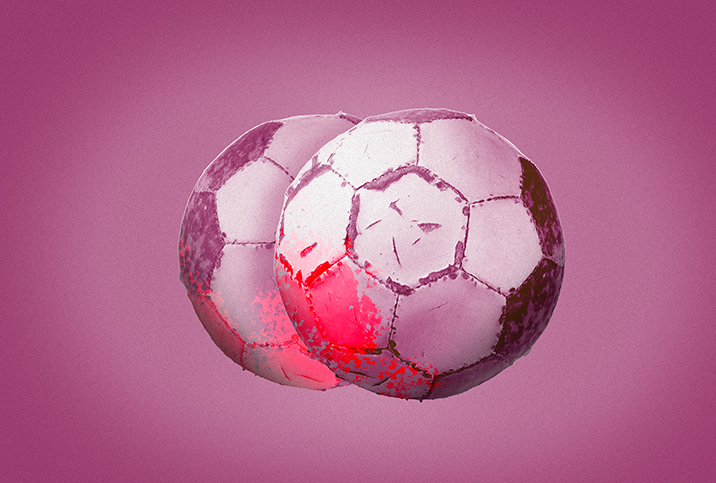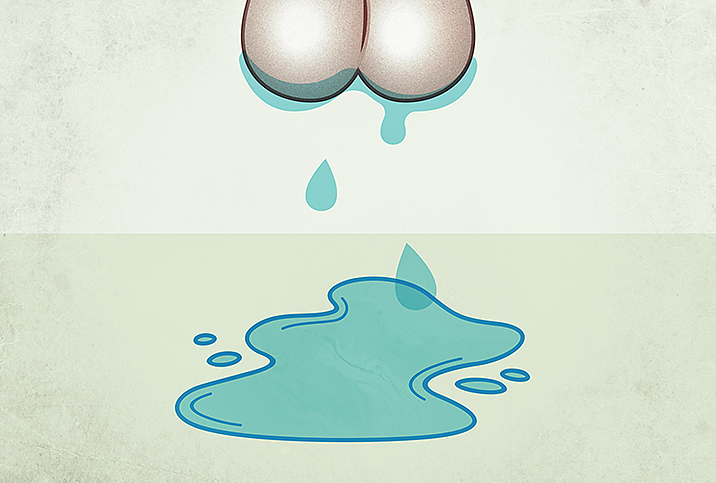Itchy Balls? Broken Skin? It Could Be Intertrigo

Itchy scrotal skin sends many men to urology and dermatology offices each year. One of the most common causes of itchiness on and around the scrotum is intertrigo, an inflammatory skin condition. Both men and women get intertrigo in skinfolds, typically in the inguinal folds—the area between the abdomen and the thigh—because that area is particularly prone to getting warm and sweaty.
"We see it often in the summer when it's 90 degrees and you just can't get cool," said Amy Kassouf, M.D., a dermatologist at Cleveland Clinic. "We also see it in the winter when people are really bundled up and there's not much air circulation."
When intertrigo arises in the summer or winter, it often presents as an itchy rash that can look like red patches in the creases and areas of skin friction. As it recurs or becomes chronic, there may be discoloration, known as hyperpigmentation.
"Intertrigo is a straightforward clinical diagnosis where the exam, history and symptoms will easily point to a diagnosis," said Susan Massick, M.D., a dermatologist at Ohio State University Wexner Medical Center. "It is a common condition for dermatologists to diagnose, but you may not be aware of it until it happens to you."
If a case of intertrigo leads to a yeast infection, which can happen with a breakdown of the skin, there may be odor, drainage and small red bumps in the affected areas.
Intertrigo risk factors and prevention
Risk factors for intertrigo include the following:
- Moisture
- Perspiration with exercise
- Staying in sweaty workout clothes
- Not washing after a workout
- Obesity
- Diabetes, especially when poorly controlled
- A suppressed immune system
- Environmental factors, for example, hot and humid summer months
- Malnutrition
And the doctors we spoke to recommended the following prevention tips:
- Avoid skin-on-skin contact (friction)
- Minimize moisture because damp, warm environments increase the potential for yeast and fungus to proliferate
- Practice good hygiene, such as using antibacterial soap
- Dry the area with a towel as much as possible after showering
- Use a fan or hair dryer on the cool setting to get the area as dry as possible
- Wear loose clothing, such as cotton boxers, instead of form-fitting underwear or spandex-type undergarments and workout clothes, to give your skin a break
Distinguishing intertrigo from other itchy ball conditions
Other common offenders when it comes to a scrotum in need of scratching include inverse psoriasis and tinea cruris, known as jock itch. Inverse psoriasis is sometimes mistaken for intertrigo because they both cause an itchy, inflamed rash.
Inverse psoriasis, an autoimmune condition, is more common in people with a family history of the condition and patients who had another type of psoriasis in the past.
If the rash does not improve with antifungal treatment, a dermatologist may suspect inverse psoriasis. If the rash is accompanied by an unpleasant odor, it's more likely to be intertrigo and it will respond better to antifungal treatments.
Compared to intertrigo, inverse psoriasis also tends to have more of a bright pink color when inflamed, Massick said. Jock itch, on the other hand, is often extremely itchy and may have more overlying scale, particularly around the leading edges of the infection.
"Intertrigo is kind of this physiologic phenomenon of these warm, sweaty areas that actually make a lot of the normal skin bacteria overgrow and start to become irritating," Kassouf explained.
Treatment and prognosis for itchy testicles
Once you notice the intertrigo flaring, it's important to treat it quickly. Massick recommended skin barrier creams with zinc oxide, such as Desitin. If the area is significantly irritated, a topical prescription steroid may be needed for the inflammation, and if there is a fungal component, a topical antifungal might be added. A topical antibiotic may be necessary if there is a secondary staph skin infection.
Kassouf recommended Zeasorb AF, which can help wick some of the sweat away and keep the area drier. It contains the antifungal medicine clotrimazole, which can help prevent yeast infections.
"You don't want to use cornstarch," Kassouf said. "You don't want to use talc. Cornstarch can actually feed the yeast. Talc is actually more of an irritant."
After taking a shower, patting the area dry and using a cool hair dryer, intertrigo patients can apply a small amount of over-the-counter clotrimazole cream. Kassouf sometimes suggests just such a solution.
"That can be something that takes the edge off and gives it time to heal," she added.
While intertrigo is generally not a serious condition, it can be chronic, recurrent and bothersome in terms of its symptoms and appearance. Massick said the prognosis is "excellent" if the common culprits—skin friction and moisture—are minimized. If the condition is not kept in check, then it will likely recur and can become symptomatic: inflamed, red, itchy and even smelly if a yeast infection occurs.
"Generally speaking, it's a nuisance," Kassouf said. "However, it can progress if not treated. The skin can fissure or crack, and then you get a more serious bacterial infection. I have seen that more in people who are heavier with deeper skinfolds. It can become a real problem."


















